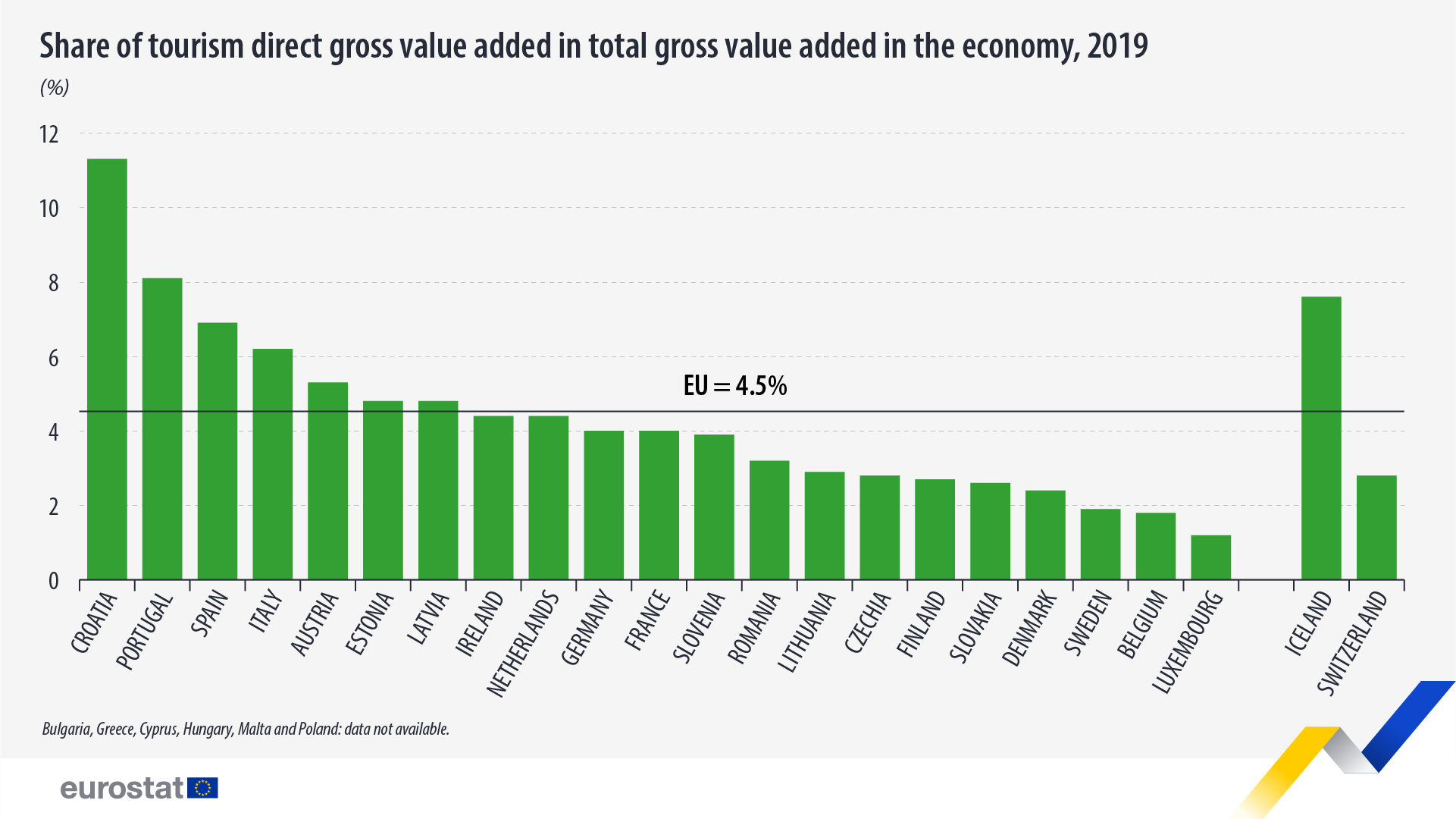Tourism: €572 billion gross value added in the EU

In 2019, the last year before the COVID-19 pandemic heavily hit the tourism sector, the gross value added directly generated by tourism amounted to an estimated €572 billion, or 5% of the total gross value added in the EU economy.
Among the countries for which data are available, the highest shares of tourism in total gross value added were observed in Croatia (11%), Portugal (8%), Spain (7%), Italy (6%) and Austria (5%). In absolute terms, the highest tourism direct gross value added was generated in Germany (€124 billion), followed by Italy (€100 billion) and France (€87 billion).
Source dataset: Ad-hoc voluntary data collection on Tourism Satellite Accounts 2022
Tourism direct gross value added: -32% in the first year of the pandemic
Based on 2020 data for around half of the EU countries, total direct gross value added dropped by €184 billion ( 32% compared with 2019) during the first year affected by the pandemic, causing a decrease in the share of the tourism sector in the economy (-1 percentage point; pp). This drop at the annual level corresponded to €500 million less daily direct gross value added in 2020 compared with 2019.
The tourism sector's decline aligns with earlier national account estimates. In 2020, among the 64 industries in the economy, three of the four that experienced over 25% decrease in gross value added were tourism-related: travel services (-67% compared with 2019), air transport (-66%), and hospitality (-41%).
Would you like to know more?
Today, Eurostat has published the report "Tourism Satellite Accounts in Europe". Tourism Satellite Accounts (TSA) is a methodological framework developed by the United Nations, UN World Tourism Organisation, Eurostat, and the OECD to measure tourism activity and its significance to national or regional economies. The report shares key TSA indicators from 27 European countries (23 being EU members) based on voluntary submissions, primarily focusing on 2019 data. It also features a special chapter with partial 2020 data, offering initial insights into the effects of the COVID-19 pandemic on European tourism.
For more information
- Tourism Satellite Accounts in Europe – 2023 edition
- Tourism Satellite Accounts: Recommended Methodological Framework 2008
- Thematic section on tourism
- Database on tourism
Methodological notes:
- Bulgaria, Greece, Cyprus, Hungary, Malta and Poland: data on tourism direct gross value added not available.
- Partial data for 2020 provided by 14 countries: Czechia, Denmark, Spain, France, Lithuania, Luxembourg, Hungary, the Netherlands, Austria, Portugal, Slovenia, Finland, Sweden and Iceland. The 13 EU countries represent around 54% of European tourism (based on the average weight in supply-side and demand-side statistics), and the totals presented may therefore not be necessarily representative of the EU.
- The figures presented in this article’s text are rounded.
- It should be noted that the indicators used in this article relate to the tourism direct gross value added and do not include indirect effects contributing to the importance of tourism to the economies. Indirect effects are not part of the Tourism Satellite Accounts methodological framework but can be important.
- In Tourism Satellite Accounts, a country's tourism direct gross value added mainly involves spending by domestic and foreign tourists within that country. However, it can also include value added created by local service providers, like airlines or travel agencies, for trips residents take abroad.
If you have any queries, please visit our contact us page.

